Frederik Ruysch's Anatomical Dioramas |

|
Frederik Ruysch (1638-1731) was a Dutch anatomist and a pioneer in techniques of preserving organs and tissue. In addition to his scientific contributions, he made artistic arrangements of his material. He had his own museum of curiosities, and among the displays were a number of dioramas assembled from body parts and starring melodramatic fetal skeletons. A few of these were captured in meticulous detail "drawn from life" by the engraver Cornelius Huyberts. These engravings were inserted as foldouts in various early 18th century editions of Ruysch's works.
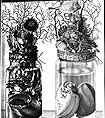 |
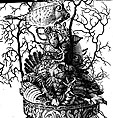 |
 |
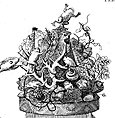 |
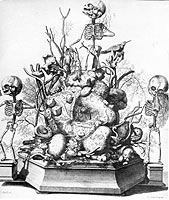 |
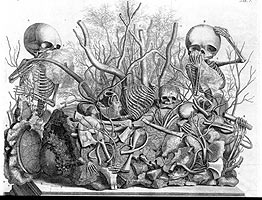 |
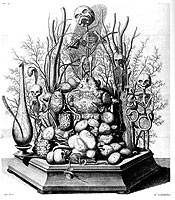 |
|
"Ruysch made about a dozen tableaux, constructed of human fetal skeletons with backgrounds of other body parts, on allegorical themes of death and the transiency of life...Ruysch built the 'geological' landscapes of these tableaux from gallstones and kidneystones, and 'botanical' backgrounds from injected and hardened major veins and arteries for "trees," and more ramified tissue of lungs and smaller vessels for 'bushes' and 'grass.' The fetal skeletons, several per tableau, were ornamented with symbols of death and short life - hands may hold mayflies (which live but a day in their adult state); skulls bemoan their fate by weeping into 'handkerchiefs' made of elegantly injected mesentery or brain meninges; 'snakes' and 'worms,' symbols of corruption made of intestine, wind around pelvis and rib cage. Quotations and moral exhortations, emphasizing the brevity of life and the vanity of earthly riches, festooned the compositions. One fetal skeleton holding a string of pearls in its hand proclaims, 'Why should I long for the things of this world?' Another, playing a violin with a bow made of a dried artery, sings, 'Ah fate, ah bitter fate.'"-- Stephen Jay Gould in Finders, Keepers: Eight Collectors
A second arena of creativity for Ruysch was creating natural history assemblages to decorate the tops of jars of preserved animal specimens. None of these assemblages or the dioramas are known to have survived to the present day. However, Ruysch had a third medium, which was the preservation of decorated babies in jars. The story of these works and haunting photographs by Rosamond Purcell are found in Finders, Keepers: Eight Collectors
Two of the detail images of the dioramas are from the U.S. National Library of Medicine's Dream Anatomy online exhibit
The third diorama detail is from BibliOdyssey's anatomical engraving collection
The jar images are from Ruysch's "Thesaurus Animalium" of 1710, reproduced here courtesy of the Department of Special Collections, Stanford University Libraries